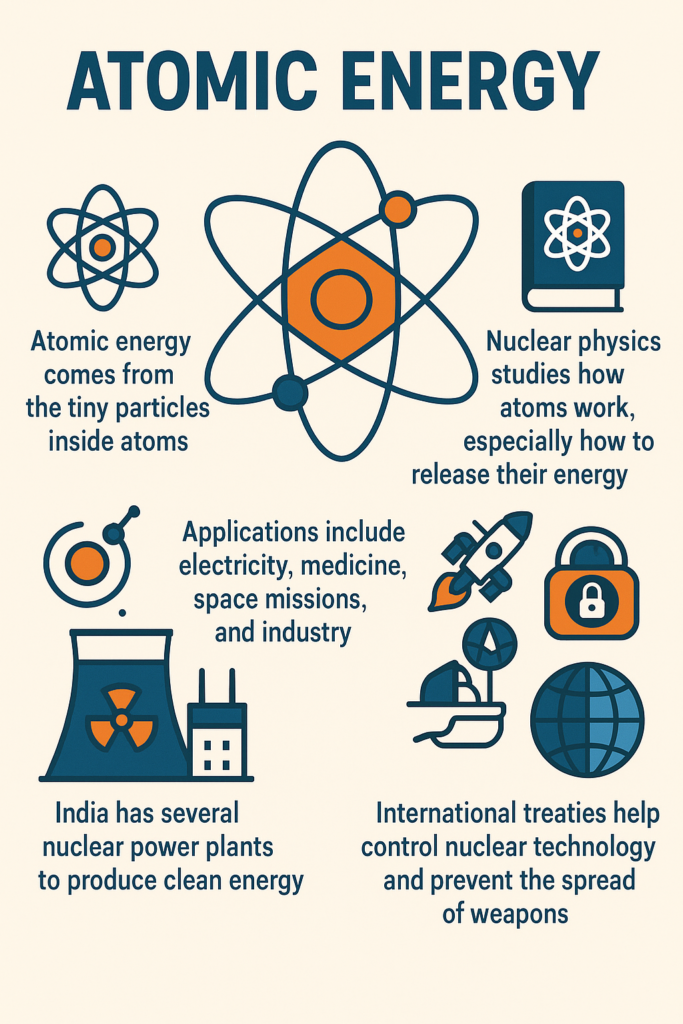Atomic energy comes from the energy stored in the tiny particles that make up atoms. Nuclear science studies how atoms work, especially how we can use their energy for things like electricity, medicine, and even space exploration.

Basics of Nuclear Physics
- Atoms: Everything around us is made of atoms. Atoms have a center called the nucleus (like the core) and tiny particles called protons and neutrons inside it, surrounded by electrons.
- Nuclear Reactions: Atoms can change through reactions called nuclear fission (splitting an atom) or nuclear fusion (combining atoms).
- Fission: Splitting the nucleus of an atom releases a lot of energy. This is what happens in nuclear power plants.
- Fusion: Combining two atoms to form a heavier one, releasing even more energy. This is how the sun produces energy.
Applications of Nuclear Energy
Nuclear energy is used in many areas:
- Electricity Generation: Nuclear power plants produce electricity by using the heat from fission to make steam, which turns turbines.
- Medical Uses: Nuclear energy helps in cancer treatment (radiation therapy) and medical imaging (like X-rays and PET scans).
- Space Exploration: Nuclear power is used in spacecraft to generate energy for long missions.
- Industrial Uses: It’s used for checking metal structures, sterilizing medical equipment, and even in food preservation.
🏭 Nuclear Power Plants in India
India has several nuclear power plants, including:
- Kudankulam Nuclear Power Plant (Tamil Nadu): The largest in India, using pressurized water reactors.
- Tarapur Atomic Power Station (Maharashtra): The first nuclear power plant in India, using boiling water reactors.
- Rajasthan Atomic Power Station: Uses heavy water reactors.
- Other Plants: In places like Gujarat, Karnataka, and Andhra Pradesh.
India plans to build more nuclear plants to meet growing energy demands while reducing carbon emissions.
International Nuclear Treaties
Countries around the world have agreements to control nuclear energy and prevent its misuse. Some key treaties include:
- The Non-Proliferation Treaty (NPT):
- Purpose: To prevent the spread of nuclear weapons and promote peaceful uses of nuclear energy.
- Key Points:
- Nuclear-armed countries agree not to share nuclear weapons.
- Non-nuclear countries agree not to develop them.
- The Comprehensive Nuclear-Test-Ban Treaty (CTBT):
- Purpose: Bans all nuclear explosions for testing purposes.
- Status: Not yet fully in force because some key countries haven’t signed it.
- The Nuclear Suppliers Group (NSG):
- Purpose: Controls the export of nuclear materials and technology to prevent nuclear weapons spread.
- The International Atomic Energy Agency (IAEA):
- Role: A global organization that promotes peaceful use of nuclear energy and ensures safety and security through inspections.
Summary:
- Atomic energy comes from the tiny particles inside atoms.
- Nuclear physics studies how atoms work, especially how to release their energy.
- Applications include electricity, medicine, space missions, and industry.
- India has several nuclear power plants to produce clean energy.
- International treaties help control nuclear technology and prevent the spread of weapons.
Tags: Andhra Pradesh, Atomic Energy, atoms, boiling water reactors, carbon emissions, clean energy, Comprehensive Nuclear-Test-Ban Treaty (CTBT), electricity generation, electrons, energy release, food preservation, global agreements, Gujarat, heavy water reactors, industrial uses, inspections, International Atomic Energy Agency (IAEA), Karnataka, Kudankulam Nuclear Power Plant, medical imaging, neutrons, Non-Proliferation Treaty (NPT), nuclear fission, Nuclear fusion, nuclear power plants, nuclear safety, nuclear science, nuclear security, Nuclear Suppliers Group (NSG), nuclear technology, nucleus, peaceful use, PET scans, pressurized water reactors, protons, radiation therapy, Rajasthan Atomic Power Station, Space exploration, sterilization, Tarapur Atomic Power Station, X-rays


